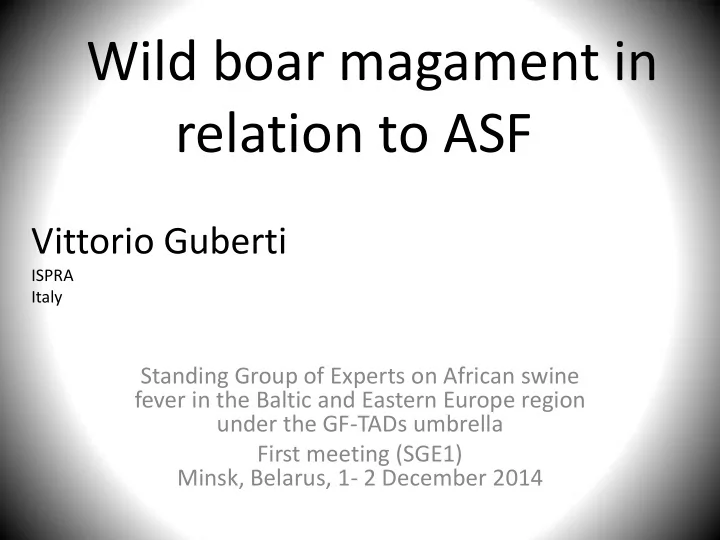

Wild boar magament in relation to ASF Vittorio Guberti ISPRA Italy Standing Group of Experts on African swine fever in the Baltic and Eastern Europe region under the GF-TADs umbrella First meeting (SGE1) Minsk, Belarus, 1- 2 December 2014
Background SCIENTIFIC REPORT OF EFSA, 2010 Scientific Opinion on African Swine Fever; SCIENTIFIC REPORT OF EFSA, 2014 Scientific Opinion on African swine fever (update of 2010); Evaluation of possible mitigation measures to prevent introduction and spread of African swine fever virus through wild boar;
Management of ASF in wild boars ASF eradication/control • No vaccination; • At present it is possible only: - Modulate Hunting Strategies - Modify Artificial Feeding Strategies - Capture and sterilization
Hunting strategies • Depopulation • Selective hunting • Hunting ban • Each strategy has to consider: • Promptness; • Acceptability; • Feasibility; • side effects on ASF spread;
Depopulation • Depopulation means to eliminate almost 80% of the REPRODUCTIVE stock of a wild boar population; • In practice, hunting from October to February, it means to shot more than 90% of the post- reproductive population; • Wild boar estimates are imprecise (usually under- estimation of 20-30%); • Nobody knows at which wild boar density ASF virus will fade out;
Depopulation • Promptness: is almost impossible to shot 90% of a wild boar in a short time (less than 3 months); from the ecological perspective it means the local extinction of the wild boar; • Acceptability: hunters will not accept to eradicate their game species; wild boar is also an important prey for large predators (Wolf, Brown Bear etc.) • Feasibility: impossible to shot 90% of the post- reproductive population before the next reproductive season (April)
Depopulation side effects • Increasing of the wild boar home ranges and thus their encounter rate; • Star shaped home ranges in response to disturbance; • Chaotic, long range, movements due to social group disruption; increased probability of new outbreaks or incursions in free areas; • Home range: size of the vital area
Home range size variations Normal home range Home range shape when depopulation
Depopulation • Imprecise wild boar size estimates are use to reach an unknown threshold density for ASF eradication through a not accepted and not feasible hunting effort; • Depopulation in absence of - biosecurity in hunting procedures - increases the probability of spreading the virus to domestic pigs; • Side effects are prevalent considering the feasibility of the intervention;
Selective hunting • A specific wild boar age and/or gender class is overhunted in order to decrease the whole population size; • The hunting bag is usually composted by 60% of juveniles, 30% of sub-adults and 10% of adults; • Generally is requested to increase the percentage of the sub-adult fraction of the population;
Selective hunting • Selective hunting has been already proposed (soft hunting) for the eradication of CSF in wild boar in central Europe. • It is a medium term strategy (~ 5 years) • According to the central-south European demographic data, overhunting of selected female age classes could drive to a limited decrease of the population (10%/year); • Lack of data for north Europe
Selective hunting • Promptness: medium term strategy; • Acceptability: high • Feasibility: low • Side effects: adult animals will deliver more piglets; sub-adult animals will be soon recruited in the reproductive fraction of the population;
Hunting ban • Avoid disturbance; • Avoid risk of further spread of the virus when dressing, transporting shot animals;
Hunting ban • Promptness: high • Feasibility: high • Acceptability: low • Side effects: increased agricultural damages; medium term increase of the population; limited sample size for active surveillance;
Artificial winter feeding • At present artificial feeding is aimed in reducing the natural winter mortality • It allows high wild boar densities even in areas where wild boars could hardly survive to the winter;
Artificial winter feeding • It is believed to reduce the winter home range and thus the contact rates among wild boars; • It reduces winter crop damages; • It increases the probability of hunters to encounter wild boars (hunting towers)
WINTER FEEDING • Lithuania: 10.000 hectares => 125 tons/year • Estonia => 50 tons cereals/year for feeding points ( 50 tons year are enough to grow approximately 100 fattening pigs ) • Ukraine => up to 5-7 tons for each estimated wild boar • Poland => 143 million tons/year (PLOS, 2014)
BAN of winter feeding • Increases winter mortality and thus REDUCES population density • Reduces many ecological undesired side- effects (local extinction of plants, super- predation etc.);
BAN of winter feeding • Promptness: high • Acceptability: low among hunters and local farmers (local market for low quality cereals and byproducts); • Feasibility: high • Side effects: increased home ranges; increased winter crop damages
Capture and sterilization • Females are captured and injected with sterilizing drugs; • The sterilizing effect lasts for about 2 years; • Decreasing of the population without the side effects of hunting;
Capture and sterilization • Lack of demographic data to validate the strategy; • Italy, France, Germany….need to capture almost 70% of females to maintain stable the population; • Meat consumption of chemical sterilized animals • Cost of capture extremely high (1.000 euro/trap, personnel, baiting of traps, etc.)
Capture and sterilization • Promptness: low • Acceptability: low among hunters, high among conservationists; • Feasibility: low (if none) • Side effects: none important; A dream rather than a management option
Contrasting measures • Winter feeding and selective hunting; • Winter feeding and depopulation; • Winter feeding and hunting ban
ASF and Wild Boars: final considerations • There are no magical receipts; • Each strategy has is own side effects and probability of success; • Technically the less dangerous strategy would be hunting ban and feeding ban together ; • Contrasting measures should be avoided; • Still lack of very important data that would help in better evaluate strategies;
Thank you for you attention Any question ?
Recommend
More recommend